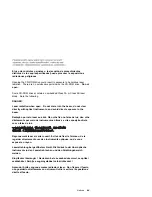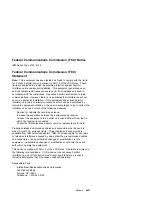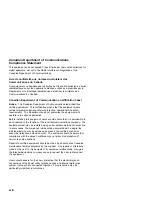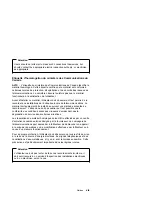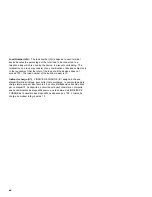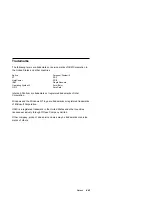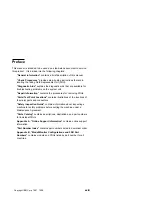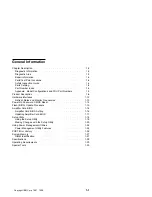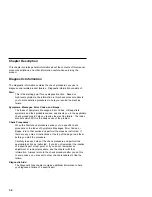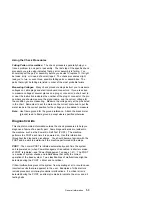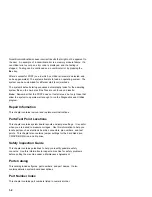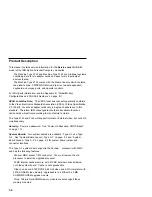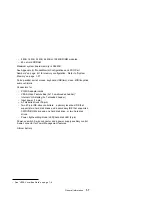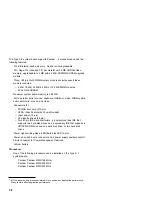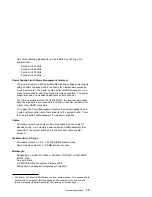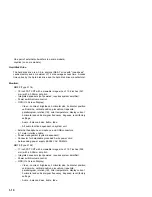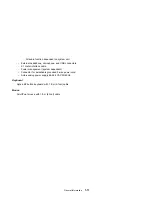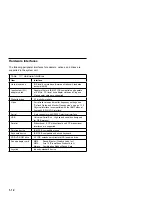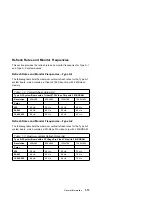
Using the Check Procedures
Failing Parts or Assemblies: The check procedures generally help you
trace a problem to one part or assembly. The last step of the specific check
procedure you are using indicates that a part or assembly is failing. You
should inspect the part or assembly before you decide to replace it. It might
be loose, dirty, or in need of a small repair. The check procedures might
lead you to two, or even three, possible failing parts or assemblies. The
parts that might be failing are listed in order of the most probable failure.
Measuring Voltages: Many check procedure steps instruct you to measure
voltages on cable plugs and electronic board connectors. If you are asked
to measure voltage at several places on a plug or connector, a chart next to
or near the instruction indicates the number of the plug or connector, the pin
numbers you should measure, the signal name, and the correct voltage for
the condition you are measuring. Measure the voltage only at the pins listed
in the chart. Remember to set the meter on the correct scale and to put the
meter leads in the correct position for the voltage you are asked to measure.
Note: Use frame ground for the ground reference. Attach the black meter
(ground) lead to frame ground, except where specified otherwise.
Diagnostic Aids
This chapter contains information outside the check procedures to help you
diagnose a failure of a specific part. Some diagnostic aids are resident in
the machine, such as the Power-On Self Test (POST). The machine
performs the POST each time it is powered on. Use this information
throughout the diagnostic procedures. You should become familiar with the
POST and be able to determine if the machine performed all the steps.
POST: The normal POST is initiated automatically each time the system
unit is powered on (when Power Management is enabled, a shorter version
of POST is initiated—see “Power Management” on page 1-21). The POST
is a series of system checks and initializations that verify the correct
operation of the base system. Two classifications of malfunctions might be
detected during the POST: critical and noncritical.
Critical malfunctions prevent the system from operating at all, or could cause
incorrect results that are apparent to the user. Examples of critical errors
include processor or interrupt controller malfunctions. If a critical error is
detected during the POST, an attempt is made to indicate the error, and all
testing halts.
General Information
1-3
Summary of Contents for Aptiva 2140
Page 2: ......
Page 8: ...vi...
Page 24: ...xxii...
Page 26: ...xxiv...
Page 128: ...3 14...
Page 132: ...2010 Cover Do not lift the cover too high as the tabs might break 4 4...
Page 134: ...Figure 4 2 3 5 In Cage 4 6...
Page 136: ...JP7 JP6 JP4 J2 J1 Figure 4 4 Console cable removal 4 8...
Page 138: ...Figure 4 7 Removing the console 4 10...
Page 139: ...Figure 4 8 Removing the console bottom plate Figure 4 9 Console spring Repair Information 4 11...
Page 170: ...6 2...
Page 174: ...Assembly 2 Machine Type 2140 System Unit Interior SL A 1 3 4 5 6 2 7 4...
Page 178: ...Assembly 4 Machine Type 2142 System Unit Interior SL A 1 3 4 5 7 6 2 7 8...
Page 181: ...Assembly 5 Diskette Hard Disk Drives and Zip Drive 3 1 4 4 4 2 Parts Catalog 7 11...
Page 185: ...Assembly 7 CD DVD ROM Drive Modem and TV Cards 3 5 1 2 4 6 Parts Catalog 7 15...
Page 196: ...8 4...
Page 206: ...B 8...
Page 211: ......



